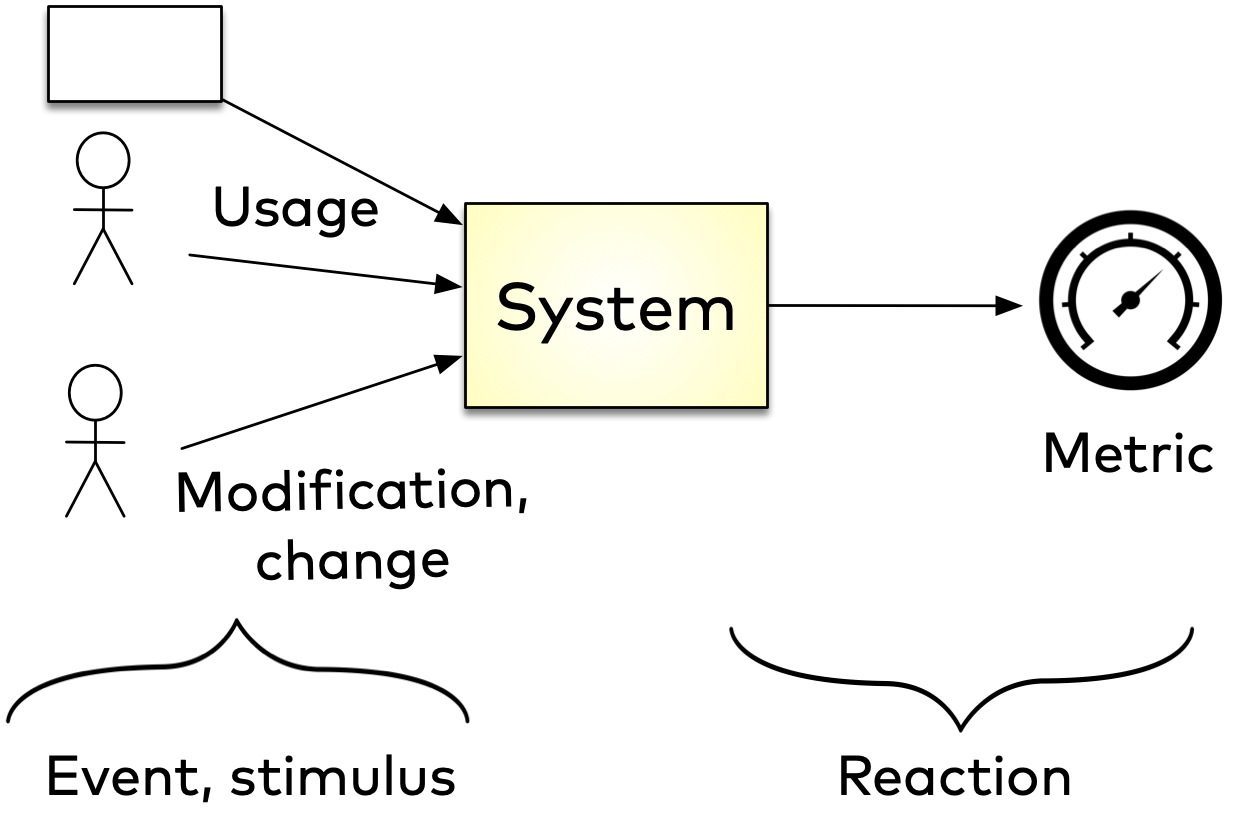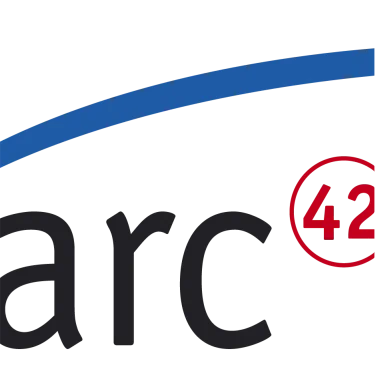Quality is such a vague and broad term that it needs clarification for system development projects.
Consider the following examples of quality requirements:
- An authenticated user requests generation of the daily sales report in PDF format via the graphical user interface. The system generates this report in less than 10 seconds.
- When a user configures a health insurance contract, the system calculates a price estimate based on the currently available information. This estimate must be within a ±15% margin relative to the final price.
- The user registration service must be available 7x24h 99%.
- A new insurance tariff can be implemented in the system in less than 10 days.
- A service crashed at runtime. It can be restarted to a fully operational state in less than 30 seconds.
These sentences, in natural language, describe requirements or expectations of stakeholders in a quite specific and measurable manner. Formulating requirements this way allows a development team to know what needs to be achieved and what is good enough.
You find 114 examples of such quality requirements on this site (see examples).
The SEI Approach: Quality Attribute Scenarios
Len Bass and his colleagues from the Software Engineering Institute (SEI) coined the term “quality attribute scenarios” for structured quality requirements. See Bass et al., 2021 for details.
Quality scenarios are a pragmatic, easy-to-use approach to specifying quality requirements. The SEI template includes six elements:

- Source of stimulus: The entity (person, system, or other actor) that generates the stimulus
- Event/stimulus: Any condition or event arriving at the system
- Artifact: The part of the system that is affected by the stimulus
- Environment: The conditions or context under which the stimulus occurs
- Response: How the system should react to the stimulus
- Metric (response measure): Measurable criteria to objectively assess whether the requirement is met
Why the Full SEI Template Can Be Impractical
Although the SEI template is widely used in academia and large-scale projects, it has some drawbacks in practice:
- Time-consuming: The detailed nature makes it slow to complete, especially when documenting many scenarios
- Over-engineering: Teams might feel compelled to fill out all six sections in detail, even when some elements are obvious or unnecessary
- Poor fit for agile: The comprehensive approach doesn’t align well with fast-paced, iterative development methodologies
- Redundancy: Source, Artifact, and Environment often repeat information that’s clear from context
In practice, a more streamlined approach is often sufficient while maintaining clarity and measurability.
The Pragmatic Approach: Two-Tier Quality Requirements
We propose a flexible two-tier approach that balances simplicity with the need for context when necessary. This approach focuses on what matters most: making requirements useful as acceptance criteria in real software development projects.
Tier 1: Simple Requirements
Use this structure for straightforward requirements where context is obvious or minimal.
When to use:
- The requirement is self-explanatory
- Context is obvious from the title
- Single actor or trigger
- 1-3 simple acceptance criteria
- Examples: performance thresholds, simple capacity requirements, test execution time
Structure:
#### Requirement
[One clear statement of what must be achieved]
#### Acceptance Criteria
- [Specific, measurable criterion with numeric threshold]
- [Additional criteria if needed]
- [Use concrete metrics: percentages, timeframes, thresholds]
Example: Quick Unit Tests
Requirement
All automated unit tests for a subsystem must execute quickly to enable rapid feedback during development.
Acceptance Criteria
- All unit tests for a subsystem complete in less than 180 seconds
- Test execution time is measured on standard CI/CD infrastructure
Tier 2: Complex Requirements
Use this structure when business or technical context is essential to understand the requirement.
When to use:
- Business/regulatory context is important
- Multiple stakeholders or complex scenarios
- 4+ acceptance criteria
- Compliance or security requirements
- Examples: access control, data quality, fairness, regulatory compliance
Structure:
#### Context
[1-3 sentences explaining the system, business constraint, or why this matters]
#### Trigger
[Who or what initiates this requirement - user action, system event, etc.]
#### Acceptance Criteria
- [Specific, measurable criterion with numeric threshold]
- [Additional criteria...]
Example: Access Control Enforcement
Context
The system operates in a multi-user environment with varying levels of user roles and permissions. Sensitive features and confidential information require role-based access control (RBAC) and audit trails to maintain data security and privacy.
Trigger
A user attempts to access a sensitive feature or confidential information within the system.
Acceptance Criteria
- 100% of access attempts must be authenticated before granting access to sensitive data
- Multi-factor authentication (MFA) is implemented for highly sensitive data
- User roles are precisely defined with least-privilege access
- 100% of access attempts are logged in a tamper-proof audit trail including user identity, timestamp, accessed data, and outcome
- Access permissions can be revoked immediately with changes effective within 60 seconds
- User sessions automatically timeout after 30 minutes of inactivity
- Access control violations are logged and reported within 5 minutes
Writing Effective Acceptance Criteria
Regardless of which tier you use, acceptance criteria should follow these best practices:
1. Be Specific - Use concrete numbers, percentages, timeframes
- ✅ “Response time < 500 milliseconds for 95% of requests”
- ❌ “System should be fast”
2. Make Them Measurable - Each criterion should be testable
- ✅ “99.9% of duplicate patient records are detected”
- ❌ “System detects most duplicate records”
3. Include Units - Always specify units for measurements
- ✅ “Deployment completes in less than 2 hours”
- ❌ “Deployment is quick”
4. Use Thresholds - Define acceptable ranges
- ✅ “Data synchronization latency ≤ 30 seconds”
- ❌ “Data synchronizes quickly”
5. Be Testable - Criteria should map directly to test cases
- ✅ “100% of failed login attempts are logged within 5 seconds”
- ❌ “Failed logins are tracked appropriately”
Common Metrics to Include
- Percentages: “95% of users”, “99.9% accuracy”, “100% compliance”
- Time bounds: “within 500 msec”, “less than 2 hours”, “maximum 30 minutes”
- Thresholds: “±10% margin”, “20% reduction”, “≤ 0.05 difference”
- Counts: “zero critical vulnerabilities”, “fewer than 2 issues per page”
- Uptime: “99.99% availability”, “SLA of 99.9%”
Examples by Domain
Performance Requirements (Usually Tier 1)
Requirement
Search results must be displayed near-instantly to maintain user engagement.
Acceptance Criteria
- First search result appears within 500 milliseconds
- Additional results load progressively without blocking UI
- 95th percentile response time remains under 800 milliseconds
Data Quality Requirements (Usually Tier 2)
Context
Healthcare system manages patient data across multiple departments where poor data quality could lead to incorrect diagnoses or medication errors.
Trigger
Patient data is entered, updated, or accessed throughout the care journey.
Acceptance Criteria
- Patient identification duplicate detection rate ≥ 99.9%
- Critical clinical fields (allergies, medications, diagnoses) are 100% complete
- Laboratory results available within 5 minutes with 99.9% reliability
- Data validation prevents 100% of impossible values and missing mandatory fields
- Complete audit trail maintained with 100% traceability
Accessibility Requirements (Often Tier 2)
Context
The web application must comply with WCAG 2.1 Level AA standards to ensure accessibility for users with disabilities.
Trigger
A user with visual impairment navigates the application using a screen reader.
Acceptance Criteria
- 95% of interactive elements are navigable with screen reader
- 98% of content is accessible and consumable
- 95% of functionality can be used without accessibility barriers
- Messages and errors announced with 99% accuracy
- Page load times remain under 3 seconds despite accessibility enhancements
- Zero critical WCAG violations in automated testing
- Maximum 2 issues per page in manual testing
Migrating from SEI Format
If you’re currently using the full SEI template, you can easily migrate to this pragmatic approach:
SEI Format:
Background: Developer deploys a new version of the application
Source: Developer
Stimulus: Deploys new version
Artifact: Production application
Environment: Production environment
Reaction: Application is fully rolled out
Metric: Deployment takes less than 2 hours
Pragmatic Format (Tier 2):
Context: The development team needs to deploy application
updates frequently with minimal downtime.
Trigger: Developer initiates deployment of a new version
to production.
Acceptance Criteria:
- Deployment to all production servers completes in less than 2 hours
- Zero downtime during deployment
- Rollback capability available within 5 minutes if issues detected
The pragmatic version consolidates the six SEI elements into three focused sections, eliminating redundancy while maintaining all essential information.
Summary
Quality scenarios document and clarify required quality attributes in a pragmatic, measurable way. They transform the abstract term “quality” into concrete, testable criteria that development teams can work with.
The two-tier Q42 approach offers:
- Simplicity for straightforward requirements (Tier 1)
- Rich context when needed for complex scenarios (Tier 2)
- Measurable acceptance criteria that serve as immediate test cases
- Faster documentation compared to the full SEI template
- Better agile fit with just-enough documentation
We recommend starting with Tier 1 for most requirements and upgrading to Tier 2 only when context genuinely adds value. This keeps your quality requirements lean, clear, and actionable.
Try the pragmatic Q42-Quality-Scenario approach in your own projects—it strikes the right balance between rigor and practicality.
Related Resources:
